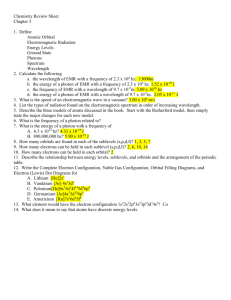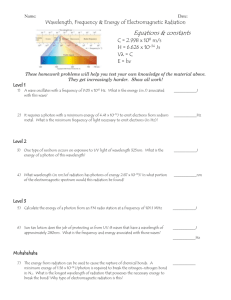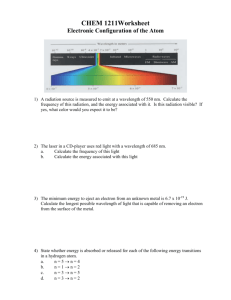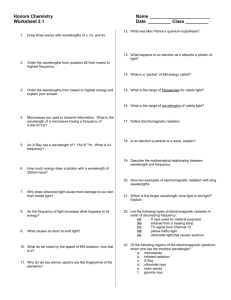Chem 1 Ch. 5 Review Key - Dr. Casagrande's eClassroom
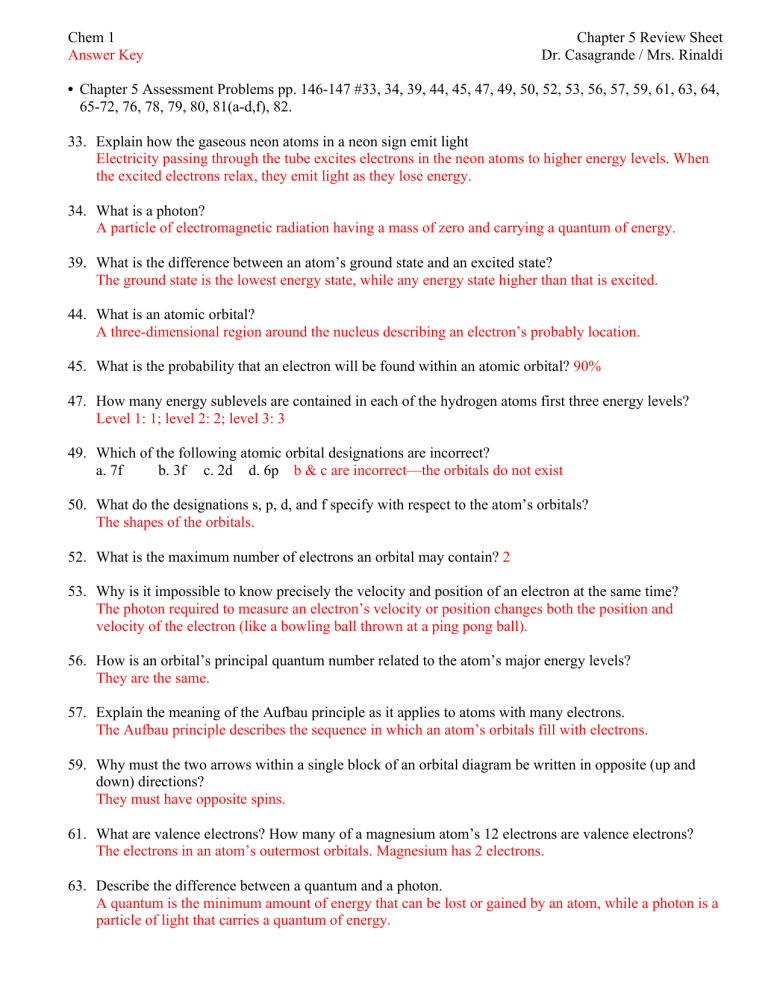
Chem 1
Answer Key
Chapter 5 Review Sheet
Dr. Casagrande / Mrs. Rinaldi
• Chapter 5 Assessment Problems pp. 146-147 #33, 34, 39, 44, 45, 47, 49, 50, 52, 53, 56, 57, 59, 61, 63, 64,
65-72, 76, 78, 79, 80, 81(a-d,f), 82.
33. Explain how the gaseous neon atoms in a neon sign emit light
Electricity passing through the tube excites electrons in the neon atoms to higher energy levels. When the excited electrons relax, they emit light as they lose energy.
34. What is a photon?
A particle of electromagnetic radiation having a mass of zero and carrying a quantum of energy.
39. What is the difference between an atom’s ground state and an excited state?
The ground state is the lowest energy state, while any energy state higher than that is excited.
44. What is an atomic orbital?
A three-dimensional region around the nucleus describing an electron’s probably location.
45. What is the probability that an electron will be found within an atomic orbital? 90%
47. How many energy sublevels are contained in each of the hydrogen atoms first three energy levels?
Level 1: 1; level 2: 2; level 3: 3
49. Which of the following atomic orbital designations are incorrect? a. 7f b. 3f c. 2d d. 6p b & c are incorrect—the orbitals do not exist
50. What do the designations s, p, d, and f specify with respect to the atom’s orbitals?
The shapes of the orbitals.
52. What is the maximum number of electrons an orbital may contain? 2
53. Why is it impossible to know precisely the velocity and position of an electron at the same time?
The photon required to measure an electron’s velocity or position changes both the position and velocity of the electron (like a bowling ball thrown at a ping pong ball).
56. How is an orbital’s principal quantum number related to the atom’s major energy levels?
They are the same.
57. Explain the meaning of the Aufbau principle as it applies to atoms with many electrons.
The Aufbau principle describes the sequence in which an atom’s orbitals fill with electrons.
59. Why must the two arrows within a single block of an orbital diagram be written in opposite (up and down) directions?
They must have opposite spins.
61. What are valence electrons? How many of a magnesium atom’s 12 electrons are valence electrons?
The electrons in an atom’s outermost orbitals. Magnesium has 2 electrons.
63. Describe the difference between a quantum and a photon.
A quantum is the minimum amount of energy that can be lost or gained by an atom, while a photon is a particle of light that carries a quantum of energy.
2
64. How many electrons are shown in the electron-dot structures of the following atoms? a. carbon 4 b. iodine 7 c. calcium 2 d. gallium 3
65. What is the wavelength of electromagnetic radiation having a frequency of 5.00
× 10 12 electromagnetic radiation is this?
Hz? What kind of c = λν : 3.00
× 10 8 m/s =
( 5.00
× 10 12 )
ν so λ =
3.00
× 10 8
= 6.00
× 10 − 5
66. What is the frequency of electromagnetic radiation having a wavelength of 3.33
×
10 –8 electromagnetic radiation is this?
s − 1
5.00
×
10 12
m/s
s − 1
m ; IR (see below)
m? What type of c = λν : 3.00
× 10 8 m/s =
( 3.33
× 10 − 8 m )
ν so ν =
3.00
× 10 8
3.33
× 10 − 8
m/s
= 9.01
× 10 15 Hz ; UV (see below)
m
67. The laser in a compact disk (CD) player uses light with a wavelength of 780 nm. What is the frequency of this light?
λ = 780 nm
68. What is the speed of an electromagnetic wave having a frequency of 1.33
×
10
2.25 nm?
×
1 × 10 − 9
1 nm
m
= 7.80
× 10 − 7 m; ν = c
λ
=
3.00
× 10
7.80
×
10
8
− 7
m/s
m
= 3.84
× 10 14 Hz
17 Hz and a wavelength of
All electromagnetic radiation travels at a speed of 3.00
× 10 3 m/s
66 69c
65
69b
69a
69. Use Figure 5-5 to determine each of the following types of radiation: a. radiation with a frequency of 8.5
× 10 b. radiation with a wavelength 4.2 nm
11 s –1 Microwaves (see above)
4.2
× 10 –9 m: X-rays c. radiation with a frequency of 5.6 MHz d. radiation that travels at a speed of 3.00
× 10 8
5.6
× 10 6 Hz: Radio waves
m/s All EM radiation
70. What is the energy of a photon of red light having a frequency of 4.48
×
10 14 Hz?
E photon
= h
ν =
(6.626
×
10 − 34 J
⋅ s)(4.48
×
10 14 s − 1 )
=
2.97
×
10 − 19 J
71. Mercury’s atomic emission spectrum is shown below. Estimate the wavelength of the orange line. What is its frequency? What is the energy of an orange photon emitted by the mercury atom?
λ = 615 nm ×
1 × 10 − 9 m
1 nm
= 6.15
× 10 − 7 m; ν = c
λ
=
3.00
× 10 8 m/s
6.15
× 10 − 7 m
= 4.85
× 10 14 Hz
Chapter 5 Review Chemistry 1
72. What is the energy of an ultraviolet photon having a wavelength of 1.18
× 10 –8 m?
ν = c
λ
=
3.00
1.18
×
×
10
10
8
− 8
m/s
m
= 2.54
× 10 16 Hz; E = h ν = (6.626
× 10 − 34 J ⋅ s)(2.54
× 10 16 Hz) = 1.68
× 10 − 17 J
76. If our favorite FM radio station broadcasts at a frequency of 104.5 MHz, what is the wavelength of the station’s signal in meters? What is the energy of the photon of the station’s electromagnetic signal?
ν =
104.5 MHz
×
1
×
10 6 Hz
1 MHz
=
1.045
×
10 8 Hz
λ = c
ν
=
3.00
1.045
×
×
10 8
10 8
m/s
s − 1
= 2.87 m ; E = h ν = (6.626
× 10 − 34 J ⋅ s)(1.045
× 10 8 s − 1 ) = 6.92
× 10
78. Write orbital notations and complete electron configurations for the following elements:
− 26 a. beryllium b. c. nitrogen d. aluminum sodium
J a.
1s 2s
1s 2 2s 2 b.
1s 2s 2p 3s 3p
1s 2 2s 2 2p 6 3s 2 3p c. 1s
1s 2s 2p
2 2s 2 2p 3 d.
1s 2s 2p 3s
1s 2 2s 2 2p 6 3s
79. Use noble-gas notation to describe the electron configurations of the elements represented by the following symbols: a. Mn b. Kr
[Ar]4s
[Ar]4s 2
2 3d
3d
5
10 4p 6 c. P d. Zn
[Ne]3s 2 3p 3
[Ar]4s 2 3d 10 e. Zr f. W g. Pb h. Ra
[Kr]5s
[Xe]6s
2
2
4d
[Xe]6s 2 4f 14
5d
5d
4
10 6p 2
[Rn]7s 2
4f
2
14
80. What elements are represented by each of the following electron configurations? a. 1s 2 2s 2 2p 5 fluorine (F) b. [Ar]4s c. [Xe]6s
2
2 4f
4d
4
10 calcium (Ca) neodymium (Nd) d. [Kr]5s 2 f. 1s 2 2s 2 2p 6
5p
3s 2
4
3p 6 4s 2 tellurium (Te)
3d 10 4p 5 bromine (Br)
81. Draw electron-dot structures for atoms of the each of the following elements: a. carbon
C b. arsenic
As c. polonium
Po d. potassium K e. barium Ba
82. An atom of arsenic has how many electron-containing orbitals? How many of the orbitals are completely filled? How many of the orbitals are associated with the atom’s n=4 principal energy level?
18 orbitals (1 × 1s, 1 × 2s, 3 × 2p, 1 × 3s, 3 × 3p, 1 × 4s, 5 × 3d, 3 × 4p)
15 orbitals are completely filled (all but the 3 4p orbitals, which each have 1 electron)
4 (4s, 3
×
4p)
Chemistry 1 Chapter 5 Review 3

